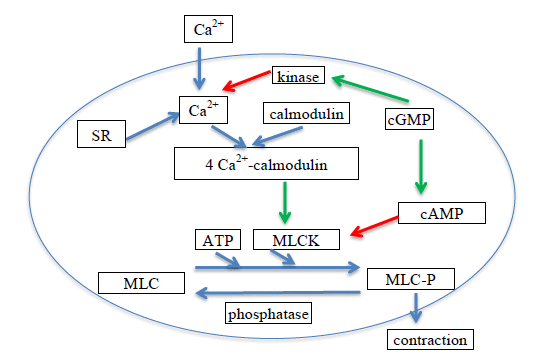VI.2. The role of nitric oxide
The endogenous production of reactive oxygen species (ROS) and NO plays an important role in the regulation of the endothelial function. The regulated production of these molecules is adequately balanced by the antioxidant systems, so that they are present in physiological amounts. The production of NO is catalyzed by nitric oxide synthase (NOS). During the reaction, L-citrulline and NO are formed from L-Arg (Fig. 21).

Figure 21. The synthesis of NO
(NADPH = β-Nicotinamide adenine dinucleotide 2′-phosphate)
The various forms of NOS may be classified according to their effects, molecular sizes and locations:
- Neuronal NOS (nNOS, NOS I): 160 kDa, constitutive, Ca2+-dependent.
- Location: in neurons.
- Roles: in stroke, ischemia and muscular dystrophy.
- Inducible NOS (iNOS, NOS II): 130 kDa, inducible.
- Location: everywhere.
- Roles: in inflammatory reaction,
autoimmune diseases and sepsis.
- Endothelial NOS (eNOS, NOS III): constitutive, Ca2+-dependent.
- Location: in blood vessel endothelium.
- Roles: in endothelial hypofunction,
atherosclerosis, high BP,
vasodilatation and anti-platelet/leukocyte effects.
Ach induces vasoconstriction only in blood vessels without an endothelium. Following the suggestion that the endothelium releases a relaxing factor (EDRF), this was identified as NO, and the precise mechanism of action was described. Robert W. Furchgott, Louis J. Ignarro and Ferid Murad (1998) received the Nobel Prize for these results.
NO plays a key role in the regulation of vasodilatation, and hence in the regulation of the BP (Fig. 22.).

Figure 22. Vasodilatation effect of NO
(The flow diagram of endothelium-dependent relaxation. Ca2+ inflow is increased by the receptors in the endothelium membrane. The increased Ca2+ level together with calmodulin activates NOS, an oxygenase. Its co-substrates are L-Arg and NADPH; its co-factors are Flavin adenine dinucleotide (FAD), Flavin adenine mononucleotide (FMN) and tetrahydrobiopterin (BH4).
The NO produced diffuses into the smooth muscle cells and activates guanylyl cyclase (GC), which leads to an enhancement of the cGMP level, which causes relaxation. L-MMA and L-NAME inhibit the function of NOS. O2- and HbO2 are NO radical scavengers. The produced and unutilized NO may transform to peroxynitrite, which is dangerous.
Ach = acetylcholine, M = Ach muscarinic receptor, B2 = bradykinin B2 receptor, GC = guanylyl cyclase, ONOO- = peroxynitrite, cGMP =cyclic guanosine monophosphate, L-MMA = Nω-methyl-L-arginine, L-NAME = NG-nitro-L-arginine)
The increased cGMP level activates kinase, which causes a decrease of the Ca2+ inflow into the cell, and decreases the Ca-calmodulin system effect on the myosin light-chain kinase (MLCK).
The phosphorylation (MLC-P) of the myosin light-chain (MLC) and the tone of the smooth muscle decrease, i.e. vasodilatation (Fig. 23).

Figure 23. The effect of cGMP vasodilatation
(Ca2+ = calcium, cGMP = cyclic guanosine monophosphate, ATP = adenosine triphosphate, MLCK = myosin light chain kinase, MLC = myosin light chain, MLC-P = MLC-phosphate)
A decrease in the amount of NO produced upsets the endothelial regulatory mechanisms and causes high BP.